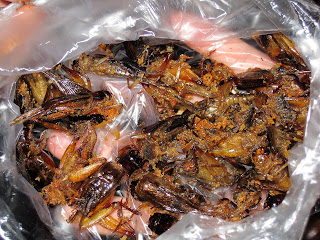 I have thin slices of finger-sized bananas covering my face and neck. I am told this will help the skin-irritations I’ve had from the heat and water. I can’t lie down because I will get banana goop all over my pillow. As I peer out of this sticky, puke-yellow colored mask, I can’t help but think of food. So for the next thirty minutes, let’s talk cockroaches, fried fish, and rotten tofu...among other things.
I have thin slices of finger-sized bananas covering my face and neck. I am told this will help the skin-irritations I’ve had from the heat and water. I can’t lie down because I will get banana goop all over my pillow. As I peer out of this sticky, puke-yellow colored mask, I can’t help but think of food. So for the next thirty minutes, let’s talk cockroaches, fried fish, and rotten tofu...among other things.I don’t exactly have a penchant for rice, but rice is a main staple in Cambodian cuisine. Even if Cambodians have finished a big meal, they are not satisfied until they have one or two hefty bowls of rice. When I dine with the Harpswell girls or my uncle’s family, they look at my cup-sized portion of rice and scowl as if I’m crazy or have an eating disorder. I assure them I don’t, but I just don’t need two large plates of rice with every meal to satiate my hunger! Cambodians I have met eat voraciously, but are stick-thin. Most people also don’t exercise, let alone walk anywhere. (Sun = UV rays. UV Rays = Tan. Tan = Dark. Dark = Ugly Cambodian). Once I find the secret to how people stay thin here despite their generous appetites, I’ll be sure to share it.
I like to think I am quite adventurous when it comes to trying new foods. In the States, I’m all over jellyfish, eel, crocodile, maybe even some Rocky Mountain oysters. I’ve come to realize in these past few weeks, however, that I’ve got nothing on Andrew Zimmerman. I don’t dare to touch many foods because of the preparation. At street stalls and markets, it is common to see a cloud of black flies swarming vegetables and floppy fish. With the wave of a hand, a vendor sends the flies away for a brief thirty seconds before they return to feast on fish guts. Even as I eat at the dormitory with the girls, flies whizz by and crawl on the mats we sit on as we eat. I ward them off by covering my bowl with one hand and waving the other in front of me. I don’t consider myself a germaphobe by any means, but I’d rather dine with human companions.
A few weeks ago, one of the girls came skipping happily through the gates of the dormitory with a ziplock full of fried chunrut, mini-cockroach looking insects. She munched happily on the insect as if she were popping Pringles one by one in her mouth. She held the plastic baggy up to me. I hesitated before searching for one with the least noticeable legs sticking out. I closed my eyes, opened my mouth, and crunched down on the protein-filled little body. Not bad, I thought. A little bit like barbecue chips with the similar crunch, a little spice and not insect-y at all (minus the antennae). I spent the next morning bent over the toilet, hurling the one insect out as well as everything else I’d eaten in the past 24 hours. Apparently, my body has yet to fully adapt to Cambodian cuisine.
Most non-insect foods, however, have not caused any abnormal bodily reactions. Food from the market, which is sometimes considered as “dangerous” for foreigners, is actually quite good. I’ve been much more satisfied with market food than with the food I’ve had at most restaurants that seem to charge more for the service than the quality of the food. Market food has the authenticity that many look for in cultural foods. Having grown up in Denver, I love authentic Mexican foods that are usually found in hole-in-the-wall family joints as opposed to Chipotle. (No offense to Chipotle because their burritos are the best phony-Mexican burritos.) I’ve been to a few moderately nice Khmer restaurants, and I must say, market food is a quarter of the price (think 75 cents for a bowl of noodles) and in the least, comparable in taste. A little forewarning however: MSG is almost as big of a staple as rice because “It [food] doesn’t taste right without,” says a woman at the market fixing me a bowl of num pang chok (a traditional Khmer rice noodle dish consisting of ginger, ground-up fish, banana leaves, mint, basil, bean sprouts, and a lime zest topping). I do my best to request food without flavor-enhancing, chemical altering MSG, and although vendors and servers respond, “Yes. Okay, Okay,” whether they really fulfill my request is unknown to me.

One of my favorite things to get at the market is thuk kalok, a smoothie. The vendors mix the freshest in-season fruits with ice for 4000 riel, just a little under a dollar. My favorite vendor is at Phsar Tuol Tom Poung, also known to foreigners as The Russian Market. I walked there two days ago from the new dormitory in Teok Thla with a friend who estimated the walk would take twenty minutes. An hour later, I showed up in the already stuffy market in my sweat-drenched robe (the term people use for dress), and in a state of dehydrated delirium. I headed straight to my thuk kalok vendor, and she saved me with her all-natural fruit smoothie, which was a mixture of thoup barang (a deep green fruit with milky flesh inside), jackfruit, and sweet mangos. Definitely worth the hour walk under the scorching sun. Plus, I got a nice tan to the dismay of Cambodians here.
And then there are the fried bananas. Jeak chien is one of those foods you know is clogging your artery as you savor the goodness on your tongue, but oh it is so good. I try not to eat one, because if I have one, then I will have another and another. These bananas are battered, producing a thick semi-crispy exterior. I love biting into one and feeling the juxtaposition of textures. There’s the initial crunch and then the smooth creaminess within. The Russian Market is famous for having the best jeak chien in the city.

I’ve yet to try street food, although I’ve stolen a bite or two from others. A lot of street food vendors cook their noodles, make their sandwiches and grill their meats on busy roads where motos, tuk-tuks, and cars practically pump exhaust and kick up dirt into the food. I have no desire to eat dirt. Many residences also employ their front yards as mini-restaurants. They serve whatever food the homeowners have cooked for the day, and some offer a small selection of goods like candy, soda, and laundry detergent.
My friend stopped in one of these homes the other day and had poung thea koun, duck egg with the developing embryo inside. This is considered to be somewhat of a delicacy, as is eating monkey brains. When I was growing up, I used to love poung thea koun. I remember begging my mother to buy these eggs whenever I saw them stacked above the heaps of bok choy and water lilies at the Asian grocery mart. I would lightly tap the narrow tip of the egg with a spoon several times until it cracked. I then peeled back the top of the eggshell, and poured in a spoonful of limejuice, coarse black pepper and salt. Once this was mixed in with the juices of the egg, I would slurp out all the liquid, leaving the solid part of the egg consisting of the baby duck and the yolk. I loved the yolk, but in order to access it, I had to dig through the rest of the solid stuff. If I was unlucky, I found the baby duck before the yolk. I never could eat the little guy with feathers and a beak. I closed my eyes and asked my father to dig out the bird, so I could have the yolk. Now, I can’t bring myself to eat poung thea koun. I probably couldn’t even get myself to tap the eggshell.
So, I have a confession to make: I bought some oatmeal. The title of my first blog post is “Leaving Oatmeal for Mudfish.” Hence, I’m supposed to leave oatmeal in America. I tried my best to stick to a strictly Cambodian diet, but my body began to feel different—not good different. Much food is cooked on a wok, meaning it is fried, and so, generous amounts of oil are used. When I use oil to cook, I am careful to use only a small amount. Meat is also eaten for every meal, including breakfast. Pork is the most common meat that is eaten. I’m not a vegetarian by any means, but I also don’t need meat for every meal. Before I came, I made a goal to eat only local cuisine—no Western food. Fail. But hey, a little cheating isn’t always bad...

I grew up eating poung thea koun, but like you I don't think I can do it...especially if I go to Cambodia.
ReplyDelete